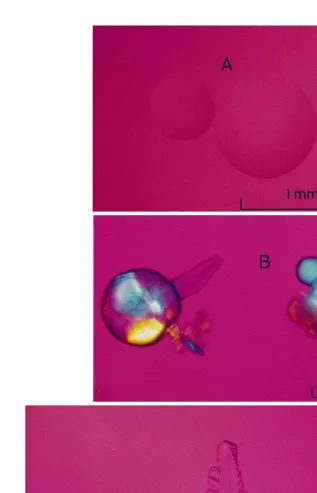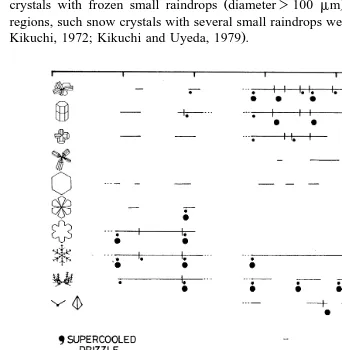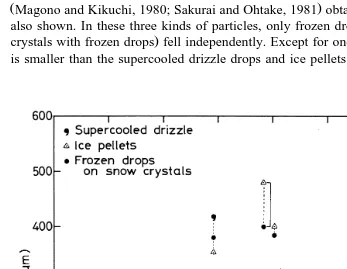www.elsevier.comrlocateratmos
Short communication
Supercooled drizzle formed by
condensation–coalescence in the mid-winter season
of the Canadian Arctic
Masahiro Kajikawa
a,), Katsuhiro Kikuchi
b,1, Yoshio Asuma
b,
Yusuke Inoue
b,2, Noboru Sato
ca
Department of CiÕil and EnÕironmental Engineering, Faculty of Engineering and Resource Science,
Akita UniÕersity, Akita 010-8502, Japan
b
DiÕision of Earth and Planetary Sciences, Graduate School of Science, Hokkaido UniÕersity,
Sapporo 060-0810, Japan
c
Science Education Institute of Osaka Prefecture, Osaka 558-0011, Japan Received 19 April 1999; received in revised form 31 August 1999; accepted 31 August 1999
Abstract
Ž . Ž X
Supercooled drizzle freezing drizzle was observed at Inuvik, N.W.T., Canada 68822 N,
X
.
133842 W on December 20, 21 and 27, 1995. Meteorological conditions in which the supercooled
Ž .
drizzle could form under low temperatures colder thany208C in the mid-winter season of the Canadian Arctic were examined from the sounding data and data measured by a passive
Ž .
microwave radiometer at ground level. The following results were obtained. 1 Supercooled
Ž .
drizzle fell to the ground with ice pellets and frozen drops on snow crystals. 2 The maximum size of supercooled drizzle particles increased as the depth of cloud layer saturated with respect to
Ž .
water increased. 3 Because a layer of air temperature higher than 08C was not detected from the sounding data at Inuvik, melting of snow particles was impossible. It was concluded, therefore, that supercooled drizzle was formed by the condensation–coalescence process below freezing temperature.q2000 Published by Elsevier Science B.V. All rights reserved.
Keywords: Supercooled drizzle; Freezing drizzle; Condensation–coalescence process; The Arctic region
)Corresponding author. Fax:q81-18-889-2653; e-mail: [email protected]
1
Present affiliation: Akita Prefectural University, Akita 010-0146, Japan.
2
Present affiliation: Japan Weather Association, Tokyo 170-6054, Japan.
0169-8095r00r$ - see front matterq2000 Published by Elsevier Science B.V. All rights reserved. Ž .
( )
M. Kajikawa et al.rAtmospheric Research 52 2000 293–301
294
1. Introduction
Ž .
The appearance of freezing rainrdrizzle supercooled rainrdrizzle is not a rare phenomenon, especially when a rain cloud or melting layer exists above a cold layer
Ž .
near the ground surface e.g., Stewart, 1992; Stewart and Crawford, 1995; Zerr, 1997 . On the other hand, it is worthy of consideration that meteorological conditions exist where supercooled rainrdrizzle could form under low temperatures in the mid-winter season of the Arctic regions.
Ž .
Ohtake 1963 reported that in cold regions, supercooled rain sometimes fell even when the temperature was below 08C, at and above the ground. As to the problem of
Ž . Ž .
formation of supercooled rain, Bocchieri 1980 and Huffman and Norman 1988 reported that about 44% and 30%, respectively, of the freezing rainrdrizzle examined by radiosonde observations had no warm layer with air temperature higher than 08C.
Ž . Ž .
Recently, Strapp et al. 1996 and Stuart and Isaac 1999 compiled the detailed climatology of freezing rainrdrizzle for North America. Moreover, in-situ aircraft observations have revealed the presence of supercooled drizzle drops in stratiform
Ž
clouds with temperatures colder than 08C e.g., Cober et al., 1995; Cober et al., 1996;
.
Isaac et al., 1996 .
A few researchers have observed supercooled raindropsrdrizzle drops in the
mid-Ž .
winter season of the Arctic region Magono and Kikuchi, 1980; Kajikawa et al., 1988 . However, in those observations, the formation mechanism has not been proved clearly. This paper describes some considerations regarding the meteorological conditions and
Ž X the characteristics of supercooled drizzle observed at Inuvik, N.W.T., Canada 68822 N,
X
.
133842 W in the mid-winter season during the experiment ‘‘Studies on Water vapor,
Ž .
Aerosols and Nuclei Transportation, and Snow Crystals in the Arctic WANTS-Arctic ’’
ŽKikuchi and Asuma, 1999 ..
2. Observations
Supercooled drizzle drops were photographed by a camera installed on a polarizing microscope. Traces of those particles spread on a glass plate showed nearly circular shapes, as seen in Fig. 1. The size of drizzle drops was derived from the calibration curve obtained by a spraying method in a cold room. In addition to the glass plate method, a catching method in a laboratory dish poured silicon oil and replica method
ŽKajikawa et al., 1988 were used for the evaluation of precipitation intensity and size.
distribution.
3. Results and consideration
Supercooled drizzle was observed on December 20, 21 and 27, 1995. Among the three cases, the maximum precipitation intensity recorded 0.0046 mmrh at 09:05
Ž . Ž .
Ž . Ž .
Fig. 1. Examples of the supercooled drizzle drops A spread on a glass plate and ice pellets B observed on
Ž .
( )
M. Kajikawa et al.rAtmospheric Research 52 2000 293–301
296
Fig. 2 shows the diurnal variation of surface air temperature and the type of precipitation particles on December 20. In the upper part of this figure, the snow crystals obtained by our observation are shown using the graphic symbols by Magono and Lee
Ž1966 and Kikuchi and Asuma 1999 , including the supercooled drizzle drops and ice. Ž .
pellets. Solid lines in this figure indicate the appearance time of the particles. The short vertical lines attached to the solid lines denote the change of riming state of crystals. The small and large solid circles beneath the solid lines indicate the rimed crystals and the
Ž .
crystals with frozen small raindrops diameter)100 mm , respectively. In the polar
Ž
regions, such snow crystals with several small raindrops were observed previously e.g.,
.
Kikuchi, 1972; Kikuchi and Uyeda, 1979 .
Fig. 2. Diurnal variation of the surface air temperature and precipitation particles at Inuvik on December 20,
Ž .
1995. Graphic symbols of snow crystals follow the manner of Magono and Lee 1966 and Kikuchi and
Ž .
Asuma 1999 . Solid lines and short vertical lines attached to them denote appearance of particles and change of riming state of crystals, respectively. Small and large solid circles beneath the solid lines indicate the rimed
Ž .
It is evident from Fig. 2 that the supercooled drizzle drops always fell with ice pellets, and snow crystals with small raindrops, even when surface air temperature was abouty238C. This situation was similar to the cases of December 21, 27.
Since the formation mechanism of supercooled drizzle drops in a polar region is a very interesting subject, for a start, it is necessary to examine the temperature and
Ž
humidity profiles of the 3 days at Inuvik Upper Air Station the distance from our
.
observation site, about 10 km . The vertical profiles of temperature and humidity with respect to water are shown in Fig. 3, at the nearest time that the supercooled drizzle appeared.
Ž
It can be seen from Fig. 3 that there are warm and saturated layers regarded as the
.
layer of relative humidity 098% accompanying a temperature inversion at about 900;800 hPa level in the three cases. The depth of these layers is about 500;1500 m
()
M.
Kajikawa
et
al.
r
Atmospheric
Research
52
2000
293
–
301
298
Table 1
Relationship between the maximum size of supercooled drizzle drops and the features of cloud layer
Date Maximum size of Maximum value of Maximum value of Depth of cloud layer
supercooled drizzle liquid water pass air temperature of the layer saturated with respect to water saturated with respect to water
ŽDma x. ŽLWP. ŽTmax. ŽDZ.
December 20, 1995 233mm 0.003 cm y11.58C 690 m
December 21, 1995 203 0.008 y9.9 530
and the temperature range is abouty7;y178C. The wind direction of the three cases was roughly from south and east around 800 and 1000 hPa level, respectively. Thus, it is suggested that the advection of warm air mass from the Pacific Ocean. Since a layer of air temperature higher than 08C was not detected in this analysis, the melting of snow crystals is impossible. It is considered, therefore, that the supercooled drizzle drops were formed in the cloud layer forming in a maritime air mass over Inuvik by condensation–
Ž .
coalescence process, as indicated by Strapp et al. 1996 .
Table 1 shows the relationship between the maximum size of supercooled drizzle
Ž . Ž .
drops Dmax and the features of cloud layer with the data of liquid water pass LWP
Ž .
measured by a passive microwave radiometer Ishida et al., 1998 at the ground level. Although the other factors do not indicate a clear correlation, the maximum size increases as the depth of saturated layer increases. The relationship between the depth of
Ž . Ž .
the saturated layer DZ and the maximum size Dmax of supercooled drizzle drops, ice pellets and frozen drops on snow crystals is shown in Fig. 4. In this figure, other data
ŽMagono and Kikuchi, 1980; Sakurai and Ohtake, 1981 obtained in the arctic region are. Ž
also shown. In these three kinds of particles, only frozen drops on snow crystals snow
.
crystals with frozen drops fell independently. Except for one case, the size of the drops is smaller than the supercooled drizzle drops and ice pellets in the sameDZ.
Ž . Ž .
( )
M. Kajikawa et al.rAtmospheric Research 52 2000 293–301
300
It is apparent from Fig. 4 that the maximum size of supercooled drizzle drops increases as the depth of water saturated layer increases. This result suggests again the condensation–coalescence process in a supercooled cloud, as the formation mechanism of supercooled drizzle drops.
4. Conclusion
Supercooled drizzle was observed at Inuvik, N.W.T., Canada on December 20, 21 and 27, 1995. Meteorological conditions in which the supercooled drizzle drops could
Ž .
form under low temperatures colder than y208C in the mid-winter season of the Canadian Arctic were examined from the sounding data. In conclusion, the following three points are indicated.
Ž .1 Supercooled drizzle drops fell to the ground with ice pellets and frozen drops on
snow crystals.
Ž .2 The maximum size of supercooled drizzle drops increased as the depth of cloud
layer saturated with respect to water increased.
Ž .3 Because a layer of air temperature higher than 08C was not detected from the sounding data at Inuvik, melting of snow particles was impossible. It was concluded, therefore, that supercooled drizzle was formed by the condensation-coalescence process below freezing temperature.
Acknowledgements
We wish to express our thanks to the staff members of the Inuvik Science Research Center, N.W.T., Canada for their support and the supply of facilities. We also express our thanks to Dr. G.A. Isaac, Atmospheric Environment Service, Canada for helpful suggestions. The expense of this research was supported by the Grant-in-Aid for
Ž .
International Scientific Research Program Field Research , Project No. 07041077 of the Ministry of Education, Science, Sports and Culture of Japan. This study was performed in part as a joint research with the Institute of Low Temperature Science, Hokkaido University.
References
Bocchieri, J.R., 1980. The objective use of upper sounding to specify precipitation type. Mon. Weather Rev. 108, 596–603.
Cober, S.G., Isaac, G.A., Strapp, J.W., 1995. Aircraft icing measurements in east coast winter storms. J. Appl. Meteorol. 34, 88–100.
Cober, S.G., Strapp, J.W., Isaac, G.A., 1996. An example of supercooled drizzle drops formed through a collision–coalescence process. J. Appl. Meteorol. 35, 2250–2260.
Huffman, G.J., Norman, G.A. Jr., 1988. The supercooled warm rain process and the specification of freezing precipitation. Mon. Weather Rev. 116, 2172–2182.
formation mechanisms. Proceedings of the 12th Int. Conf. on Clouds and Precip. Zurich, Switzerland, August 19–23, 1996, pp. 11–14.
Ishida, H., Hayasaka, T., Kajikawa, M., Kikuchi, K., Uyeda, H., Asuma, Y., Inoue, Y., 1998. Observations of liquid water, water vapor, and downward flux of infrared radiation in the Arctic region with a microwave radiometer and a pyrgeometer. Polar Meteorol. Glaciol. 12, 10–18.
Kajikawa, M., Sakurai, K., Kikuchi, K., 1988. Characteristic features of supercooled raindrops in the mid-winter season of Arctic Canada. J. Meteorol. Soc. Jpn. 66, 393–398.
Kikuchi, K., 1972. On snow crystals with small raindrops. J. Meteorol. Soc. Jpn. 50, 142–144.
Kikuchi, K., Uyeda, H., 1979. Cloud droplets and raindrops collected and frozen on natural snow crystals. J. Meteorol. Soc. Jpn. 57, 273–281.
Ž .
Kikuchi, K., Asuma, Y. Eds. , 1999. Studies on the water vapor, aerosols and nuclei transportation and the
Ž .
snow crystals of low temperature types in the Arctic regions WANTS-Arctic . Hokkaido Univ., Japan, 355 pp.
Magono, C., Lee, C.W., 1966. Meteorological classification of natural snow crystals. J. Fac. Sci., Hokkaido Univ., Ser. 7 2, 321–335.
Magono, C., Kikuchi, K., 1980. Some observations of snowfall and meteorological conditions in Arctic Canada. Mon. Weather Rev. 108, 1656–1664.
Ohtake, T., 1963. Hemispheric investigation of warm rain by radiosonde data. J. Appl. Meteorol. 2, 594–607. Sakurai, K., Ohtake, T., 1981. Frozen drops observed at Fairbanks, Alaska. Seppyo 43, 73–76.
Stewart, R.E., 1992. Precipitation types in the transition region of winter storms. Bull. Am. Meteorol. Soc. 73, 287–296.
Stewart, R.E., Crawford, R.W., 1995. Some characteristics of the precipitation formed within winter storms over eastern Newfoundland. Atmos. Res. 36, 17–37.
Strapp, J.W., Stuart, R.A., Isaac, G.A., 1996. Canadian climatology of freezing precipitation and John’s precipitation, and a detailed study using data from St. John’s, Newfoundrand. FAA Int. Conf. on Aircraft Inflight Icing, Springfield, Virginia, Vol. II, DOTrFAArAR-96r81, pp. 45–55.




